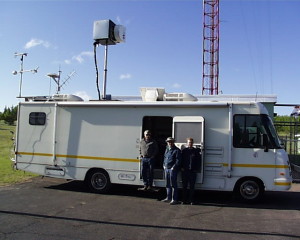“Where’s the Water Vapor?”
Madison, WI, May 21, 2002—
 UW–Madison’s Space Science and Engineering Center and Cooperative Institute for Meteorological Satellite Studies is supporting the International H20 Project (IHOP 2002) from mid-May through June, with instruments to measure the state of the atmosphere, with weather satellite information, and with scientific expertise.
UW–Madison’s Space Science and Engineering Center and Cooperative Institute for Meteorological Satellite Studies is supporting the International H20 Project (IHOP 2002) from mid-May through June, with instruments to measure the state of the atmosphere, with weather satellite information, and with scientific expertise.
This massive field experiment takes place in Oklahoma and the surrounding Plains states from May 13 through June 25. IHOP is planned to better measure humidity, rainfall and overall moisture in the air and how it all changes.
Scientists from agencies and universities in the U.S., Canada and Europe are studying the weather in the Southern Great Plains states of Kansas, Oklahoma, eastern Colorado and the Texas panhandle. The region was chosen because instruments and other facilities are already in place, but especially because moisture in the air over the Plains varies widely and spawns many storms.
The National Center for Atmospheric Research, the lead organization, hopes “that the IHOP-2002 measurements will ultimately help us in understanding when, where and how storms form and will allow us to better predict actual rainfall amounts associated with these storms.”
Like other atmospheric scientists, SSEC researchers support many field experiments, to test instruments and to collect data that will lead to better instruments, better atmospheric computer models and, in the long run, better weather forecasts.
SSEC has taken its AERIBAGO, a Winnebago converted to carry instruments, to the Oklahoma panhandle. Inside the AERIBAGO is the Atmospheric Emitted Radiance Interferometer (AERI for short), which profiles the atmosphere above it in high detail, much as a weather balloon (radiosonde) does, but from one station. While weather balloons provide highly reliable data, they must be constantly replenished, and can be difficult to recycle. The AERI stays in one place.
A small group of AERIs currently is in place in Oklahoma as part of the Department of Energy’s long-term Atmospheric Radiation Measurement Program. Along with other instruments at the site, they will provide their input to IHOP, as will a whole fleet of instruments and scientists from U.S. agencies and other universities.
From Oklahoma City, SSEC will fly its Scanning-High resolution Interferometer Sounder on NASA’s DC-8 from Dryden Research Center. SSEC also supports NASA’s NPOESS [next polar orbiting satellite] Atmospheric Sounder Testbed-Interferometer on the Proteus high-altitude research aircraft. The NAST-I is developed by NASA’s Langley Research Center in Virginia, with William L. Smith, former CIMSS director as its principal investigator.
SSEC is also providing innovative high-resolution satellite products (from GOES and MODIS data received at the center) as well as numerical weather prediction support. Well suited to regional forecasts is the Atmospheric Land EXchange Inversion (ALEXI) model which combines satellite and other data about the energy the earth receives from the sun and radiates out to space. ALEXI model development is funded by the National Science Foundation with investigators at the Pennsylvania State University.
New products derived from GOES satellite data are being tested over the IHOP domain. This higher resolution imagery, called Single Field-Of-View, provides more detail than the traditional product. These and other displays for the most recent six hours are specifically focused over the Oklahoma, Kansas and Texas Panhandle region for both forecasting assistance as well as product assessment. CIMSS and NOAA researchers working with them hope that increased exposure to displays of derived product imagery at its full resolution, purposefully enlarged over this IHOP area, will encourage wider evaluation and acknowledgment of the value-added benefits as well as the deficiencies of current GOES Sounder data.
Examples and detailed descriptions of products made from satellite data can be found at the CIMSS IHOP Web site.
Contacts: Terri Gregory, 608-263-3373
For past features and columns, see SSEC’s News page.

